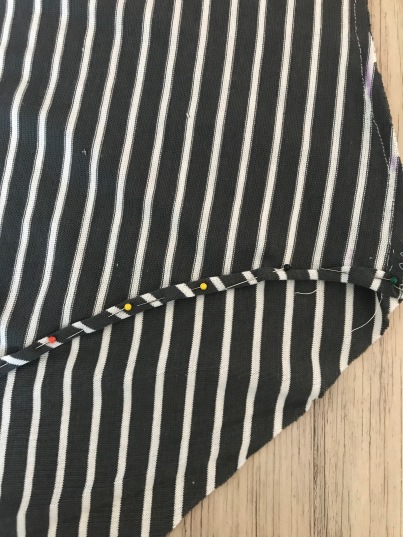




Hey guys!
I’m back with another tutorial! I am once again so proud of how this skirt turned out, but as usual I made some mistakes. Here’s what went wrong:
- I didn’t leave enough room for my hips. I used a skirt I liked the fit of to “draft” this pattern, but because I copied the cut of that skirt exactly, so I have to pull it over my head. But that’s okay it’s just as cute.
- I used too little seam allowance when I sewed the pockets. So putting my hands in the pockets is a little difficult.
I learned so many things on this project, keep scrolling to see how I made the skirt above, and for outfit details. 🙃


What you will need:
- A skirt you like the fit of
- 2 yards of fabric for the skirt, and half a yard for the pockets. (I used a linen cotton blend from fancytigercrafts.com).
- Scissors
- Tailors chalk or a fabric marker
- Elastic – measure your waist plus one inch (for seam allowance) to determine how long your elastic will be. Mine was 31 inches.
- Pins
- Safety pins
Total Cost: $23.00
Step One:
Fold your fabric in half, and lay your skirt over the fabric. Then trace around your skirt. I traced around the skirt exactly, but you will want to trace a box around the skirt, making sure to leave room for seam allowance. Once you insert the elastic it will make the skirt fitted to your waist. Most importantly, it will fit around your hips. Next time I will measure the length of my hips, and then cut out a box with the measurements (width of hips x desired length) of skirt. That will give you a skirt that pulls over your hips, but has a lot of body.
Step Two:
Cut out your skirt. So at this point my skirt will look different then yours, but the steps will be the same.
Step Three (Optional):
Cut out the pockets and pin them to your skirt. I used a tutorial from YouTube to insert my pockets, since it was my first time. Instructions for inserting pockets are much easier to watch than to write, so I haven’t included a step by step, but the pictures below give you an idea. 





Step Four:
Lay the front and the back of your skirt right sides together, and pin. Take your “skirt” to the sewing machine and stitch down the sides of your skirt, about 5/8 of an inch from the edge. Make sure once you get to the pockets you pivot and sew around them, otherwise they will be useless.


Step Five:
I created my waistband using my skirt. So I rolled the top of my skirt down twice and ironed it. At this point I knew I wanted to add a button hole to insert the elastic. So I determined which side of my fabric would face the inside of my skirt, and I stitched my button hole first. Then, I sewed the waistband to the skirt. Here is the final result:




Step Six:
Insert your elastic. Place your safety pin through one end of your elastic, then thread it all the way through the button hole in your skirt, pulling as you go. Once almost all the elastic is in the skirt, except the ends, take out your safety pin, pin the elastic right sides together, with some seam allowance and then sew a zigzag stitch straight down.


Step Seven:
Now it was time to hem my skirt, and finish any raw edges. To hem I rolled the bottom of my skirt twice, pinned it, and pressed it. Then I finished it off with a straight stitch all the way around. I then finished off any raw edges I had on the inside of the skirt, and just like that we’re done.



Thats it! The skirt is finished, I am so proud of how this project came out, and have already worn this skirt several times. This is definetely a wardrobe staple for me.




If you like the outfit, but you would rather buy, below are some similar items:
- Top similar here or tutorial here – (affiliate link)
- Skirt similar here – (affiliate link)
- Shoes JustFab, similar here and here – (affiliate link)






















